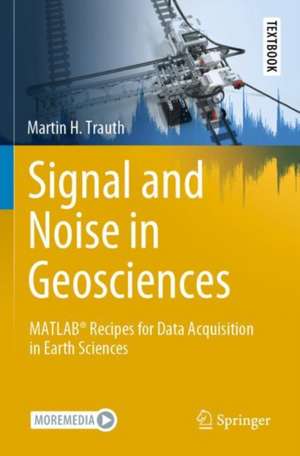Signal and Noise in Geosciences: MATLAB® Recipes for Data Acquisition in Earth Sciences: Springer Textbooks in Earth Sciences, Geography and Environment
Autor Martin H. Trauthen Limba Engleză Paperback – 7 noi 2022
Din seria Springer Textbooks in Earth Sciences, Geography and Environment
- 15%
 Preț: 541.07 lei
Preț: 541.07 lei - 17%
 Preț: 464.85 lei
Preț: 464.85 lei - 17%
 Preț: 503.23 lei
Preț: 503.23 lei -
 Preț: 375.47 lei
Preț: 375.47 lei - 15%
 Preț: 620.41 lei
Preț: 620.41 lei -
 Preț: 383.33 lei
Preț: 383.33 lei -
 Preț: 397.68 lei
Preț: 397.68 lei - 17%
 Preț: 463.55 lei
Preț: 463.55 lei -
 Preț: 508.54 lei
Preț: 508.54 lei -
 Preț: 512.38 lei
Preț: 512.38 lei - 17%
 Preț: 361.69 lei
Preț: 361.69 lei - 17%
 Preț: 370.14 lei
Preț: 370.14 lei - 17%
 Preț: 528.26 lei
Preț: 528.26 lei - 17%
 Preț: 526.71 lei
Preț: 526.71 lei -
 Preț: 361.46 lei
Preț: 361.46 lei - 13%
 Preț: 459.26 lei
Preț: 459.26 lei -
 Preț: 367.40 lei
Preț: 367.40 lei - 15%
 Preț: 665.91 lei
Preț: 665.91 lei -
 Preț: 489.30 lei
Preț: 489.30 lei - 15%
 Preț: 706.16 lei
Preț: 706.16 lei - 19%
 Preț: 522.96 lei
Preț: 522.96 lei - 15%
 Preț: 714.81 lei
Preț: 714.81 lei -
 Preț: 453.42 lei
Preț: 453.42 lei - 19%
 Preț: 447.96 lei
Preț: 447.96 lei - 15%
 Preț: 590.63 lei
Preț: 590.63 lei -
 Preț: 461.74 lei
Preț: 461.74 lei - 15%
 Preț: 721.37 lei
Preț: 721.37 lei - 23%
 Preț: 625.31 lei
Preț: 625.31 lei - 18%
 Preț: 751.29 lei
Preț: 751.29 lei - 19%
 Preț: 624.25 lei
Preț: 624.25 lei - 19%
 Preț: 578.97 lei
Preț: 578.97 lei - 15%
 Preț: 590.95 lei
Preț: 590.95 lei - 24%
 Preț: 1134.05 lei
Preț: 1134.05 lei - 19%
 Preț: 418.86 lei
Preț: 418.86 lei -
 Preț: 502.80 lei
Preț: 502.80 lei - 24%
 Preț: 684.56 lei
Preț: 684.56 lei - 15%
 Preț: 661.32 lei
Preț: 661.32 lei -
 Preț: 438.49 lei
Preț: 438.49 lei
Preț: 444.00 lei
Nou
Puncte Express: 666
Preț estimativ în valută:
84.97€ • 87.78$ • 70.72£
84.97€ • 87.78$ • 70.72£
Carte tipărită la comandă
Livrare economică 22-28 martie
Preluare comenzi: 021 569.72.76
Specificații
ISBN-13: 9783030749156
ISBN-10: 3030749150
Pagini: 340
Ilustrații: XI, 340 p. 70 illus., 63 illus. in color.
Dimensiuni: 155 x 235 mm
Greutate: 0.66 kg
Ediția:1st ed. 2021
Editura: Springer International Publishing
Colecția Springer
Seria Springer Textbooks in Earth Sciences, Geography and Environment
Locul publicării:Cham, Switzerland
ISBN-10: 3030749150
Pagini: 340
Ilustrații: XI, 340 p. 70 illus., 63 illus. in color.
Dimensiuni: 155 x 235 mm
Greutate: 0.66 kg
Ediția:1st ed. 2021
Editura: Springer International Publishing
Colecția Springer
Seria Springer Textbooks in Earth Sciences, Geography and Environment
Locul publicării:Cham, Switzerland
Cuprins
Data Acquisition in Earth Sciences.- Introduction to MATLAB.- MATLAB Programming.- Geometric Properties.- Visible Light Images.- Spectral Imaging.- Acquisition of Elastic Signals.- Gravimetric, Magnetic and Weather Data.
Notă biografică
Martin H. Trauth studied geophysics and geology at the University of Karlsruhe. He obtained a doctoral degree from the University of Kiel in 1995 and then became a permanent member of the scientific staff at the University of Potsdam. Following his habilitation in 2003 he became a lecturer, and then in 2011 a titular professor at the University of Potsdam. Since 1990 he has worked on various aspects of past changes in the climates of East Africa and South America. His projects have aimed to understand the role of the tropics in terminating ice ages, the relationship between climatic changes and human evolution, and the influence that climate anomalies had on mass movements in the central Andes. Each of these projects has involved the use of MATLAB to apply numerical and statistical methods (such as time-series analysis and signal processing) to paleoclimate time series, lake-balance modeling, stochastic modeling of bioturbation, age-depth modeling of sedimentary sequences, and the processing of satellite and microscope images. Martin H. Trauth has been teaching a variety of courses on data analysis in earth sciences with MATLAB for more than 25 years, both at the University of Potsdam and other universities around the world.
Textul de pe ultima copertă
This textbook introduces methods of geoscientific data acquisition using MATLAB in combination with inexpensive data acquisition hardware such as sensors in smartphones, sensors that come with the LEGO MINDSTORMS set, webcams with stereo microphones, and affordable spectral and thermal cameras. The text includes 35 exercises in data acquisition, such as using a smartphone to acquire stereo images of rock specimens from which to calculate point clouds, using visible and near-infrared spectral cameras to classify the minerals in rocks, using thermal cameras to differentiate between different types of surface such as between soil and vegetation, localizing a sound source using travel time differences between pairs of microphones to localize a sound source, quantifying the total harmonic distortion and signal-to-noise ratio of acoustic and elastic signals, acquiring and streaming meteorological data using application programming interfaces, wireless networks, and internet of things platforms, determining the spatial resolution of ultrasonic and optical sensors, and detecting magnetic anomalies using a smartphone magnetometer mounted on a LEGO MINDSTORMS scanner. The book’s electronic supplementary material (available online through Springer Link) contains recipes that include all the MATLAB commands featured in the book, the example data, the LEGO construction plans, photos and videos of the measurement procedures.
Caracteristici
Serves as a compact introduction to data acquisition with the most common sensors used in Earth sciences Explains each method in simple words, starting with the physics of measurement Contains construction plans and MATLAB recipes for performing desktop-size measurements
